A week post-Race to the Stones and my feet are almost back to normal size, although luckily I haven’t had to test this by putting anything like shoes on! The only day I’ve left the village was Thursday, when we went on a work team outing to Cambridge where the University Library is showing our exhibition Raymond Briggs: A Retrospective until late August.
Cambridge isn’t somewhere I have spent a great deal of time – I went to a humanist naming ceremony there once, and while Timeshare Teenager 1 was at Anglia Ruskin we popped up to see her, but other than a two-hour delay on a train back from somewhere where we got to sit in the station that’s been it. My very efficient Public Programmes Producer Jo organised the day, finding out about trains and buses, which was much appreciated by myself and the other member of the team Valentina.
Jo knows about things like group save tickets, and so we met at Kings Cross to catch the train and grab breakfast from Leon. Miraculously the trains were well-behaved all day (unlike the tube on the way home). Cambridge University Library is an impressive 1930s building which reminded us all of a power station – which makes sense now that I have discovered the architect, Giles Gilbert Scott, also worked on Battersea Power Station (and the red telephone box, which is cool).
The gallery is tucked away to the side of the main library entrance; quite a small space but the exhibition is full of sketches, roughs and proofs from some of Briggs’s best known-works like The Snowman and Father Christmas as well as from his longer graphic novels like When The Wind Blows and Ethel and Ernest. My sister’s favourite, Fungus the Bogeyman, also featured – I’d forgotten all the wonderful words in this one, and how endearing Fungus was.
We liked the simple sketch/make trails, especially playing with scale and getting messy with the giant’s footprint. We were amazed at the different illustration styles Briggs used over the years, and at the neatness of his typography for Fungus’s pages. The scrawled notes like ‘no full frontal nudity for Father Christmas’ made us laugh. When The Wind Blows brought back memories of the 80s and the very real fear of nuclear war, and The Tin-pot Foreign General and the Old Iron Woman was a stark look at the Falklands War.
If you’re in the area do go and see it – free entry and you also get to marvel at the University Library.
After leaving the library we walked through the grounds of one of the colleges, watching people punting and a fashion shoot with preppy clothes on the banks of the Cam, and made our way to Kettle’s Yard where we were planning to have lunch and a look at the Palestinian embroidery exhibition. The pavement on the way was scattered with bronze flowers, which Google informed us was the Cambridge Core and Flower Trail, inspired by a medieval coin hoard found by Anglian Water workers.
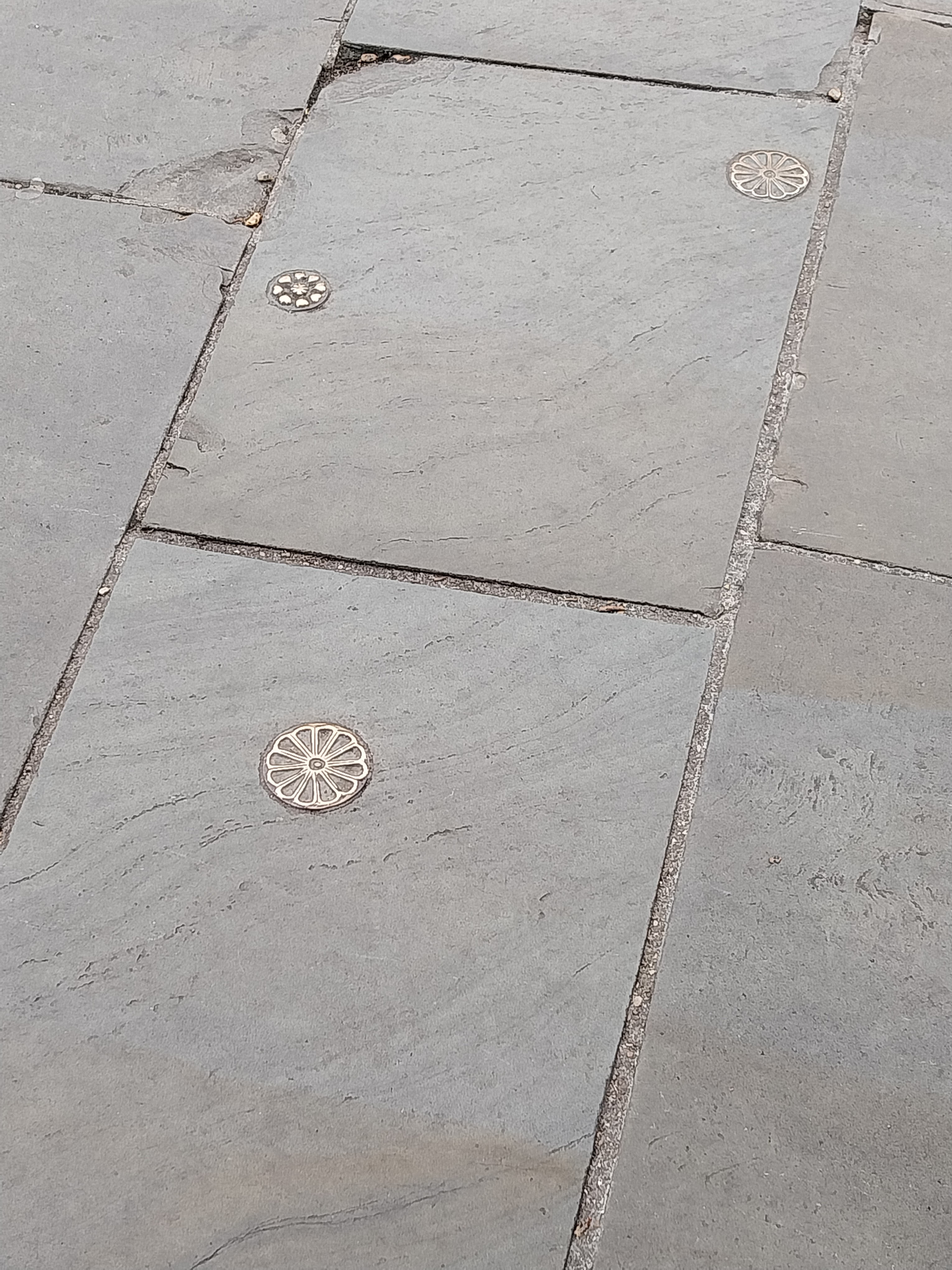
Lunch was a salad with hummus and falafel, with a lemon and ginger lemonade, while Jo and Valentina had huge vegetarian wraps. Jo tried the sticky toffee cake too, while I resisted the delicious-looking date flapjack.
Material Power
Our slot to visit the house was at 2pm, so we visited the Material Power exhibition first. The show covers both historic and modern dress, and the role of embroidery as a social signifier and a form of protest and resistance. As a cross-stitcher and very basic embroiderer, the amount of work and detail in the gorgeous garments left me speechless (I know!), especially the inside out garment where the back of the work was spectacularly neat. The image of the ’embroidered woman’ in the PLO material was striking. Upstairs was more modern clothing, and we were struck by the foregrounding of Palestinian women’s voices by simply having their video playing out loud, while the curator had to be listened to on headphones. Valentina has Palestinian ancestry, so the exhibition held personal meaning for her.
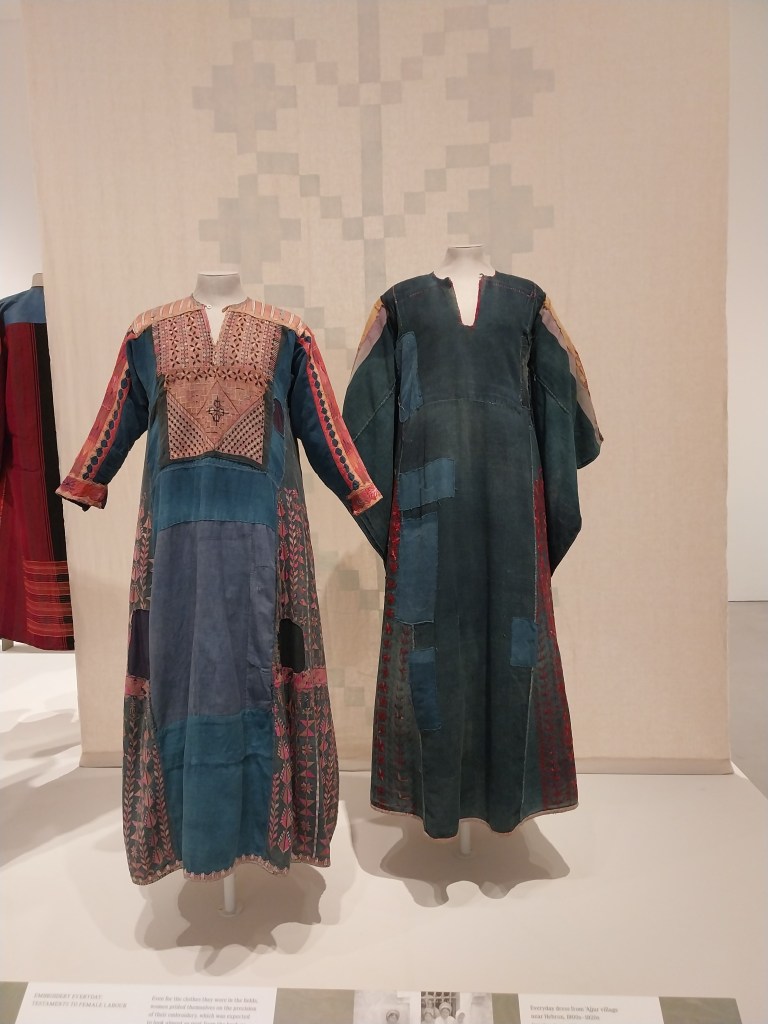
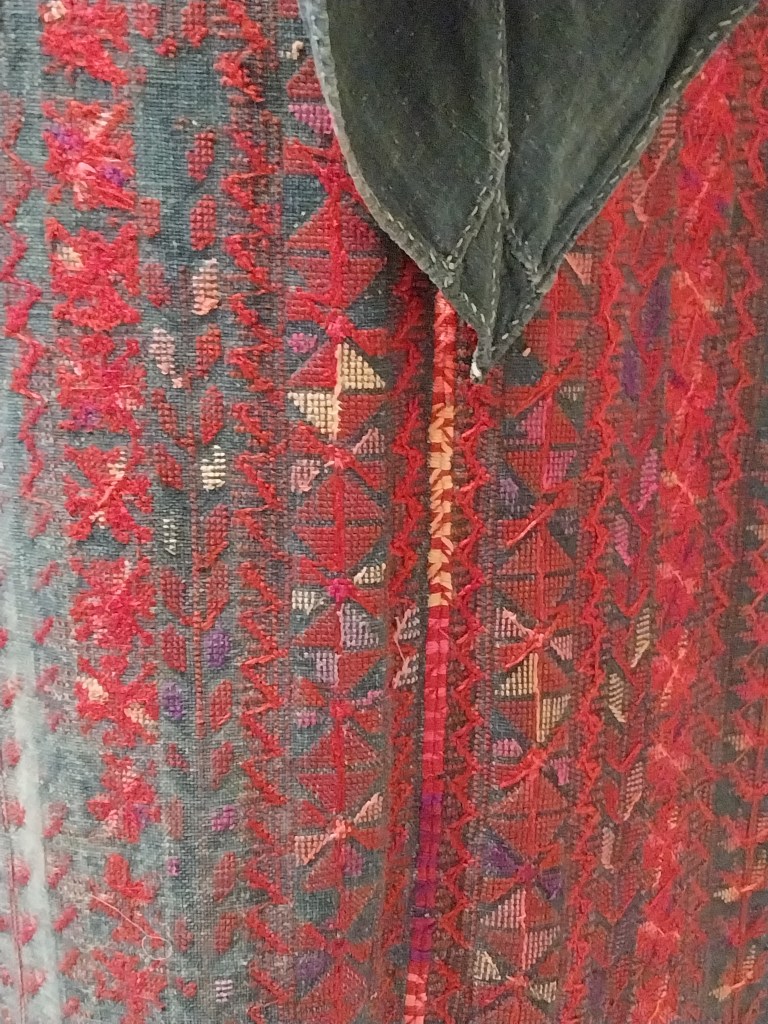


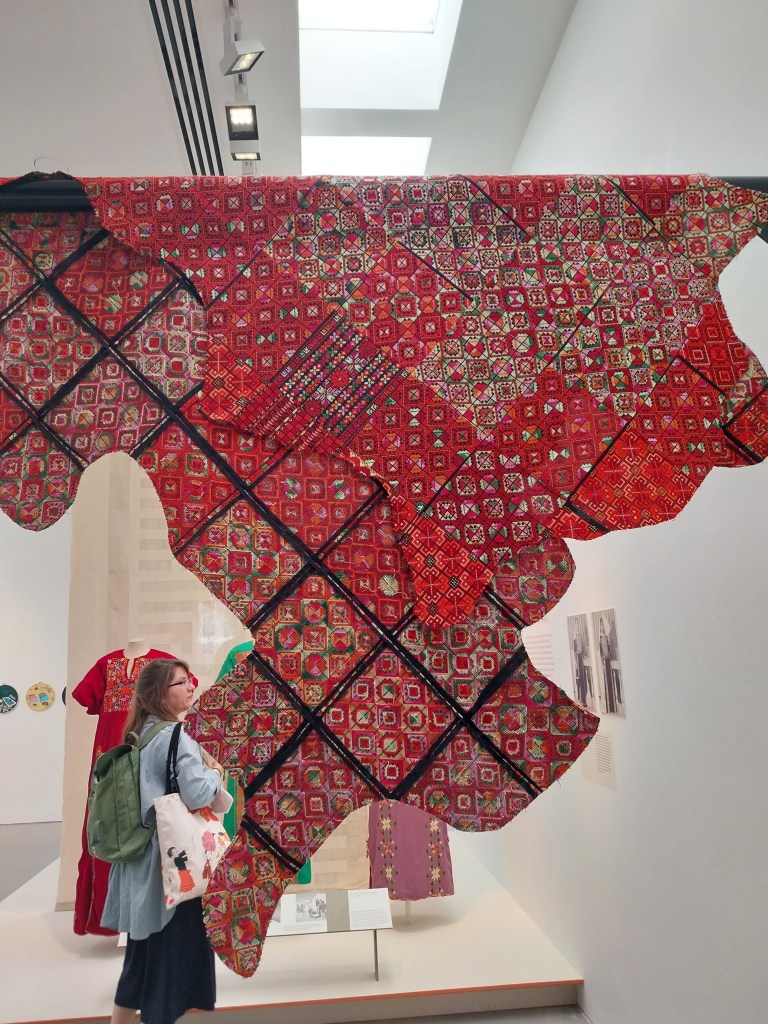
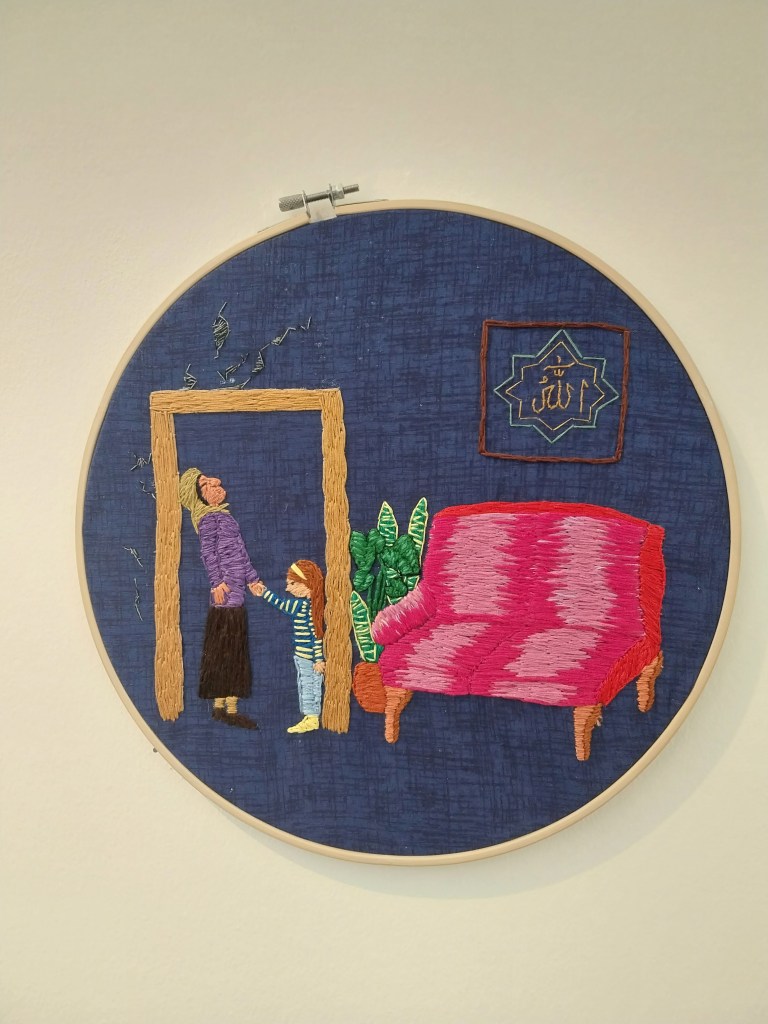

The piece that moved me most was the one above, Aya Haidar’s Safe Space series: a set of six hoop embroideries documenting her mother’s memories of growing up on Lebanon in the Civil War (1975-1990), and the steps people took to stay safe from everyday violence. Saucepan helmets and bullet proof vests, sleeping under beds, piling furniture to protect from flying glass, captured in a ‘domestic’ craft.
Finally we popped up to look at the ‘reflection and response’ space which turned out to be a corner in a corridor. The rest of the exhibition was so well done that I was a bit disappointed by this, though space is obviously an issue. There was a lot to reflect on and this felt like an afterthought.
To the house!
I’d heard of Kettle’s Yard as someone on my MA course was a volunteer there, but didn’t know much about it so had no idea what to expect. I was completely enchanted from the moment we walked in.
The website says, ‘Kettle’s Yard is the University of Cambridge’s modern and contemporary art gallery. Kettle’s Yard is a beautiful House with a remarkable collection of modern art.’ This does not do it justice. You can take a virtual tour here, but if you’re in Cambridge – perhaps to see the Raymond Briggs Retrospective! – go and visit. It’s magical in the same way that Dennis Severs’s House is: out of time, and with the sense that someone has just left the rooms. Apparently Helen and Jim Ede welcomed visitors and fed them tea and toast, and this spirit of home remains.
When your timeslot arrives you are escorted to the house where you ring a bellpull and are greeted by an incredibly knowledgeable person who clearly loves their role. You can sit in any of the chairs but you can’t touch any of the exhibits, which was frustrating for someone likes me who loves a pebble and a found object.
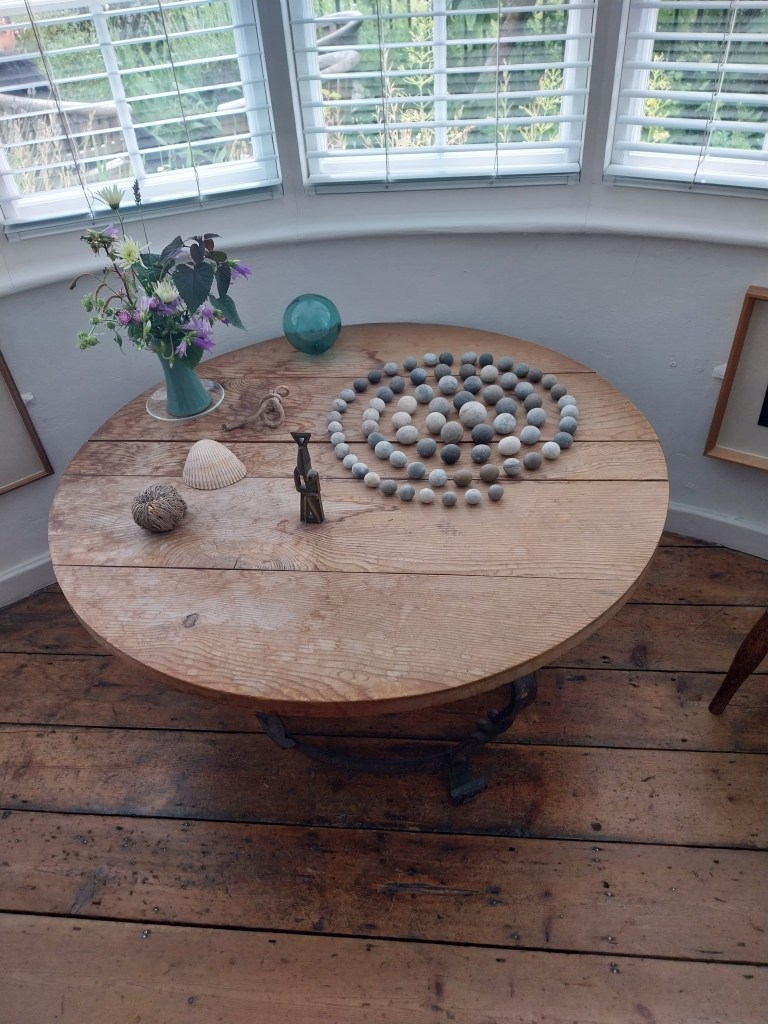





This being me, I gravitated to the packed bookshelves in Helen Ede’s room where I found such old friends as Lucy M. Boston’s Green Knowe stories (set in Huntingdon) and Sellars & Yeatman’s 1066 and All That. I wanted to find a chair and read for a while. The whole house exerts a sense of calm that I usually get from being at the seaside. Many of the paintings that called to me were seascapes, particularly Seascape with Two Boats by Winifred Nicholson where my eye was caught by the small child exploring the rocks and the Alfred Wallis Five Ships, Mount Bay which reminded me of Aberaeron.


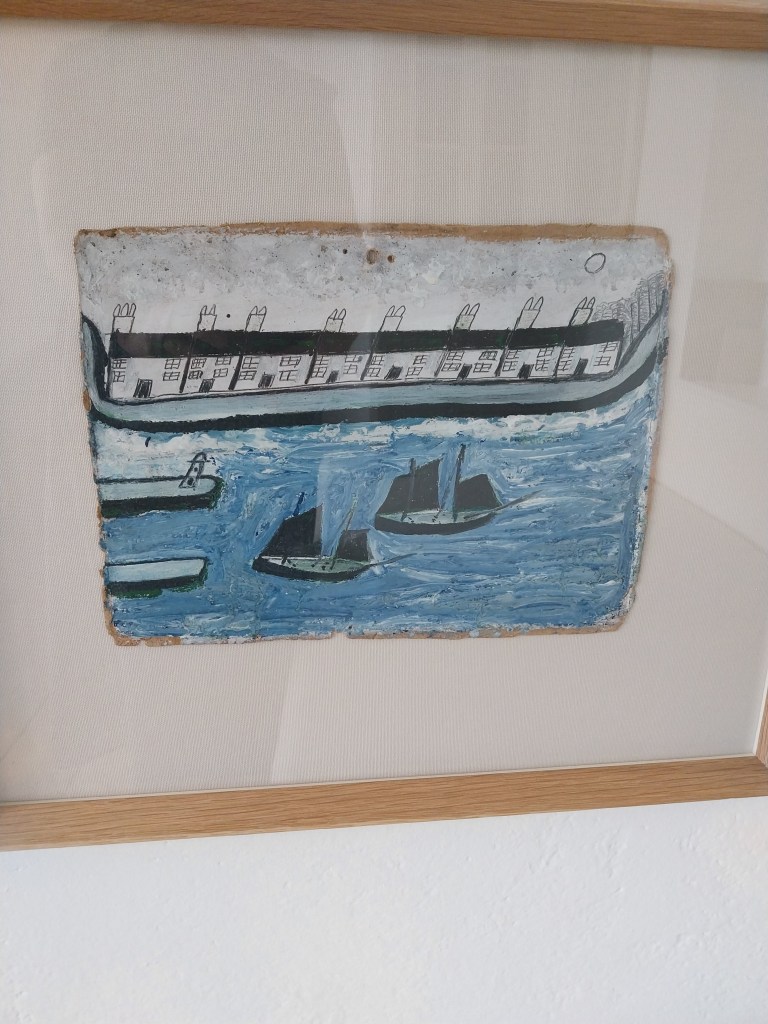


I also liked Cornelia Parker’s Verso series – photographs of the reverse of button cards from a museum collection, which highlight the work of the seamstresses who had to mount these buttons.
You can read more about Jim Ede and Kettle’s Yard here and here. If I go missing, you’ll find me tucked in a corner of his house with one of Helen’s books.
Next week will be a crafty update as I have been busy with crochet creatures, cross stitch and a make and share for the new issue of Tauko magazine. Here’s a teaser…

Kirsty x
What I’ve been reading:
Overboard– Sara Paretsky
The Ward Witch – Sarah Painter
Moon Over Soho/Whispers Underground – Ben Aaronovitch (Audible)
Emily Wilde’s Encyclopaedia of Fairies – Heather Fawcett
Desert Star – Michael Connelly
Ye Gods! – Tom Holt
The Good, The Bad and The History – Jodi Taylor